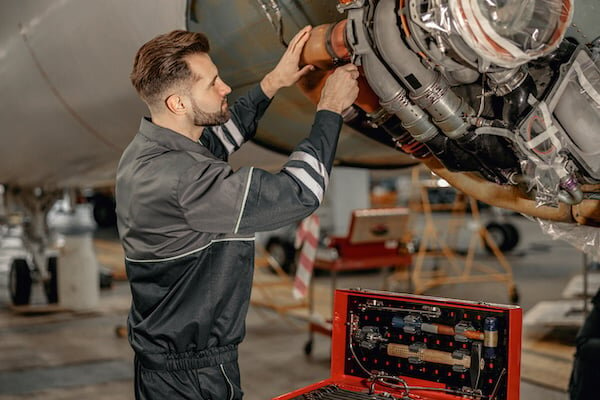Aircraft hydraulic systems must help operate many critical flight components, maintaining efficiency through the most demanding in-flight conditions. The primary use of hydraulic systems in aircraft are in the components of landing gear, brakes and flight control surfaces. Flight control surfaces are the aerodynamic devices which allow the pilot to adjust and control the aircraft's altitude. The fundamentals of aircraft hydraulics and their maintenance are consistent regardless of the size of the aircraft.
Aircraft pneumatic systems incorporate components that provide pressurization, cooling and actuation. Pneumatics are also used in sensors to deliver information about the speed and altitude of the aircraft.
MRO Aviation 
Unlike in general industry where the ‘O’ in MRO stands for “Operations,” MRO aviation stands for Maintenance, Repair and Overhaul. MRO aviation is the inspection, service and repair of an aircraft or aircraft component. By following FAA and international standards, it encompasses all the maintenance activities to ensure safety and airworthiness of all aircraft, from a single engine Cessna Skyhawk, a Bell Jetranger helicopter or even a Lockheed Martin Super Galaxy military transport.
Aviation MRO on hydraulic and pneumatic systems in aircraft is a serious job performed by trained Aviation Maintenance Engineers. However, maintenance failures are frequently caused by human error.
In a well-known incident involving British Airways Flight 5390, the captain was blown halfway out of the cockpit after the cockpit window ejected at altitude from explosive decompression, due to poor maintenance procedures. Members of the crew clung to his belt to keep him from blowing away and the captain miraculously survived with only minor injuries. However, the investigation into the incident discovered that the shift maintenance manager used the incorrect bolts to secure the window.
United Airlines Flight 232 crash-landed in Sioux City, Iowa, killing 112 passengers following uncontained engine failure and loss of hydraulics. Post-crash analysis showed the presence of a penetrating fluorescent dye used to detect cracks during maintenance. The presence of the dye indicated there was a crack and should have been detected at a prior inspection.
The crash of an F-14A fighter jet in which one person died and four others were injured was “most likely” caused by a failure in the aircraft’s hydraulic system, a Navy report concluded. An investigation into the incident raised the possibility that entrapped air, introduced into the hydraulic system during maintenance, may have contributed to the ultimate system failures that caused the accident.
Aircraft MRO on Hydraulic and Pneumatic Systems
Human error aside, the main factors to consider when repairing hydraulic and pneumatic systems in aircraft are: 
- Hydraulic fluid leaks causing pressure loss in the system
- Fluid contamination causing wear or seizing of components
Some hydraulic failures can cause the loss of an aircraft’s all-weather capability, due to the loss of the autopilot capability. As a result, the landing flap position may become unobtainable or there may be degradation in the flight control functions.
- Pneumatic components are susceptible to dirt and corrosion, leading to air bleed from components that can become stuck in the wrong position.
When these same issues arise on industrial or construction equipment, it is rarely a cause for concern to human life. When it causes failures of components on an aircraft, the result can be devastating.
Current Climate of Aviation and Aerospace MRO
Though the MRO acronym described above is an activity of aircraft maintenance, MRO is also used to describe an aircraft maintenance facility that performs the required inspection and maintenance certified under FAA guidelines.
The Covid-19 pandemic impacted Aviation MRO more than most realize. With the downturn in air travel, aircrafts around the world were essentially put into storage. While sitting dormant, environmental conditions for those stored outside, or even within hangers, impacted pneumatic bleed air systems and unattended hydraulic components. This left maintenance crews combing over every inch before releasing planes. They’ve been faced with valves that seized up due to corrosion, degraded valve packing, dried and cracked O-rings in fittings and corroded/cracked tubing and hose. Any of these factors can lead to airplane hydraulics losing the proper sealing of components, which is critical in preventing pressure loss within the system. Plastic pneumatic fittings and tubing can become cracked in dry environments.
There are many different challenges in maintenance for aircraft, often in line transmission of compressed air in pneumatics and special liquids in hydraulics. That’s why following FAA guidelines is critical to the equipment and most importantly the safety of crew and passengers.
Maintenance of Ground Support Equipment
Ground Support Equipment (GSE) is the equipment and machinery used to service aircraft during scheduled maintenance or in between flights. According to SAE AIR4286, there are “policies, procedures and practices required to maintain mobile and fixed ground support equipment at airport passenger and cargo terminals.” The primary purpose for ground support equipment maintenance is to ensure safe and serviceable equipment with minimal downtime. Maintenance programs for ground support equipment must also follow individual airport operating regulations.
While in between flights, GSE includes jetways, baggage carriers, aircraft tow tractors, refueling equipment and more.
Hydraulics are used throughout GSE equipment, such as:
- Aircraft towbars with hydraulic height adjustment
- APUs (Auxiliary Power Units)
- Fluid equipment that dispenses hydraulic fluid and engine oil
- Hydraulic cranes used in servicing engines
- Hydraulic power units (Mules) are portable ground support equipment that supplies auxiliary hydraulic power to an aircraft
As with hydraulic systems in construction and industrial equipment, fluid contamination is the primary issue in hydraulic ground support equipment, including the ingress of:
- Air from fluid deterioration or a source foreign to the system
- Chemicals that dissolve in the fluid
- Particles of any solid foreign material entering the system
- Water that enters with an additive or other solution
All of these are issues that must be maintained by MRO aircraft maintenance technicians on a scheduled service basis. The most important considerations of GSE maintenance are safety, speed and accuracy. The equipment on the ground is what helps the equipment in the air arrive safely at its destination.
Conclusion
A vital final step is the maintenance preflight checklist, which allows the crew to catch any issues or discrepancies and report them to maintenance. Any problems will either be fixed immediately or the plane will be taken out of service until the issue is resolved. In this situation, a new plane will be needed for the current flight. Most people who fly regularly know the aggravations of being directed to a different gate at the last minute-- or worse, having to deplane while on the tarmac to board another plane. We don’t usually think of the fact we were about to take off in a faulty aircraft!
The most important aspect of operating a successful airline, airport or small aviation business is adherence to a strict routine of aircraft maintenance. It is essential to keeping planes operating efficiently and economically for as many years as possible. Most importantly, aircraft MRO helps to ensure the safety of the crew and passengers.
Since you seemed interested in our aerospace content, check our Free BluePrint over MRO Aviation on Hydraulic & Pneumatic Systems.
Sources Include:

